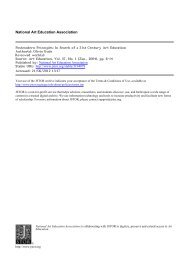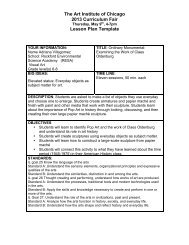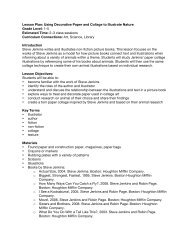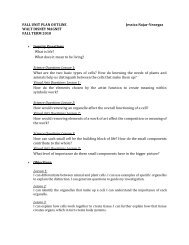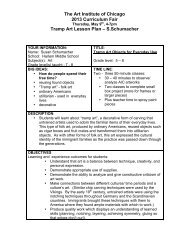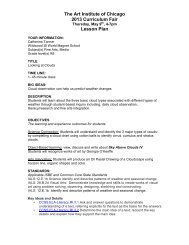Lesson 1 - LearningThroughMuseums
Lesson 1 - LearningThroughMuseums
Lesson 1 - LearningThroughMuseums
Create successful ePaper yourself
Turn your PDF publications into a flip-book with our unique Google optimized e-Paper software.
Relevant Information:<br />
• Born and raised on Chicago’s South Side, White was gifted as a child and studied art at settlement<br />
house art classes as well as at the School of the Art Institute of Chicago.<br />
• He lived in Mexico for a while in the 1940s and was inspired by Diego Rivera, who painted the<br />
struggles and dignity of workers.<br />
• By depicting images of ordinary black men and women, White communicated his experience of the<br />
courage and morality of African Americans. He said, “I’ve only painted one picture in my entire<br />
life… I see my totality of 300 years of history of black people through one little fraction …<br />
a family … my family… I don’t try to record it, but use it symbolically to make a broad universal<br />
statement about the search for dignity … the history of humanity.”<br />
• This artwork shows two southern rural farmhands as they sharpen a scythe in silence during fall<br />
harvest. Their powerful figures recall those of revolutionary Mexican murals, and are made more<br />
imposing by their placement so close to the front of the picture.<br />
• Through the use of powerful lines, shading, and scale, White has portrayed heroic and beautiful<br />
human forms. He shows how strong the workers are and that their work is important. He shows<br />
their dignity, their strength, and their commitment.<br />
The artwork: The Child’s Bath<br />
The artist: Mary Cassatt (American, 1844–1926)<br />
The topic: Inferring Values<br />
Relevant Information:<br />
• Mary Cassatt was born and raised in Pennsylvania but spent much of her adult life as a painter in<br />
France.<br />
• The Child’s Bath shows the subject matter for which Cassatt is most famous: woman and child.<br />
• Here, we see a woman bathing a young girl’s feet in a basin of water as she rests on the woman’s<br />
lap.<br />
• Although it is clear that a woman is bathing a child, we are not exactly sure where the bath is<br />
taking place. By noticing the patterned rug and sofa in the background, we can hypothesize that<br />
they are not in a bathroom but more likely a sitting room or bedroom. This was common during<br />
the time this painting was made.<br />
• In addition to images of bathing, Cassatt’s art depicts children being dressed, read to, and held.<br />
This focus on the intimate moments between women and children coincides with the era’s social<br />
and scientific views on raising children properly and tending to their health.<br />
You will find additional useful information from the following sources:<br />
Web sites<br />
• The Art Institute of Chicago<br />
Information about The Weaver:<br />
http://www.artic.edu/aic/collections/artwork/151363<br />
• Information about Harvest Talk:<br />
http://www.artic.edu/aic/collections/artwork/111810<br />
96 • <strong>Lesson</strong> 6: Inferring Values



